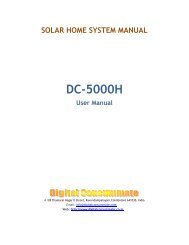How Do Solar Panel Work? A solar panel is a ... - Digital Consummate
How Do Solar Panel Work? A solar panel is a ... - Digital Consummate
How Do Solar Panel Work? A solar panel is a ... - Digital Consummate
Create successful ePaper yourself
Turn your PDF publications into a flip-book with our unique Google optimized e-Paper software.
the controller may go into “full on” mode. The controller checks the state of charge on the battery<br />
between pulses and adjusts itself each time.<br />
• MPPT <strong>Solar</strong> Charge Controller:<br />
MPPT <strong>solar</strong> charge controller schematic, A maximum power point tracker (or MPPT) <strong>is</strong> a high efficiency<br />
DC to DC converter which functions as an optimal electrical load for a photovoltaic (PV) cell, most<br />
commonly for a <strong>solar</strong> <strong>panel</strong> or array, and converts the power to a voltage or current level which <strong>is</strong> more<br />
suitable to whatever load the system <strong>is</strong> designed to drive.<br />
The most basic <strong>solar</strong> charge controller simply monitors the battery voltage and opens the circuit,<br />
stopping the charging, when the battery voltage r<strong>is</strong>es to a certain level. Older charge controllers used a<br />
mechanical relay to open or close the circuit, stopping or starting power going to the batteries.<br />
More modern charge controllers use pulse width modulation (PWM) to slowly lower the amount of<br />
power applied to the batteries as the batteries get closer and closer to fully charged. Th<strong>is</strong> type of<br />
controller allows the batteries to be more fully charged with less stress on the battery, extending<br />
battery life. It can also keep batteries in a fully charged state (called “float”) indefinitely. PWM <strong>is</strong><br />
more complex, but doesn’t have any mechanical connections to break.<br />
The most recent and best type of <strong>solar</strong> charge controller <strong>is</strong> called maximum power point tracking or<br />
MPPT. MPPT <strong>solar</strong> controllers are basically able to convert excess voltage into amperage. Th<strong>is</strong> has<br />
advantages in a couple of different areas.<br />
Most <strong>solar</strong> power systems use 12 volt batteries, like you find in cars. (Some use other voltages and the<br />
same advantages apply to these systems as well.) <strong>Solar</strong> <strong>panel</strong>s can deliver far more voltage than <strong>is</strong><br />
required to charge the batteries. By, in essence, converting the excess voltage into amps, the charge<br />
voltage can be kept at an optimal level while the time required to fully charge the batteries <strong>is</strong><br />
reduced. Th<strong>is</strong> allows the <strong>solar</strong> power system to operate optimally at all times.<br />
Another area that <strong>is</strong> enhanced by an MPPT charge controller <strong>is</strong> power loss. Lower voltage in the wires<br />
running from the <strong>solar</strong> <strong>panel</strong>s to the charge controller results in higher energy loss in the wires than<br />
higher voltage. With a PWM charge controller used with 12v batteries, the voltage from the <strong>solar</strong> <strong>panel</strong><br />
to the charge controller typically has to be 18v. Using an MPPT controller allows much higher voltages<br />
in the wires from the <strong>panel</strong>s to the <strong>solar</strong> charge controller. The MPPT controller then converts the<br />
excess voltage into additional amps. By running higher voltage in the wires from the <strong>solar</strong> <strong>panel</strong>s to the<br />
charge controller, power loss in the wires <strong>is</strong> reduced significantly.<br />
MPPT charge controllers are more expensive that PWM charge controllers, but the advantages are<br />
worth the cost. If you can afford it, you should definitely use an MPPT <strong>solar</strong> charge controller.<br />
The final function of modern <strong>solar</strong> charge controllers <strong>is</strong> preventing reverse-current flow. At night, when<br />
<strong>solar</strong> <strong>panel</strong>s aren’t generating electricity, electricity can actually flow backwards from the batteries<br />
through the <strong>solar</strong> <strong>panel</strong>s, draining the batteries. You’ve worked hard all day using <strong>solar</strong> power to<br />
charge the batteries, you don’t want to waste all that power! The charge controller can detect when<br />
no energy <strong>is</strong> coming from the <strong>solar</strong> <strong>panel</strong>s and open the circuit, d<strong>is</strong>connecting the <strong>solar</strong> <strong>panel</strong>s from the<br />
batteries and stopping reverse current flow.



